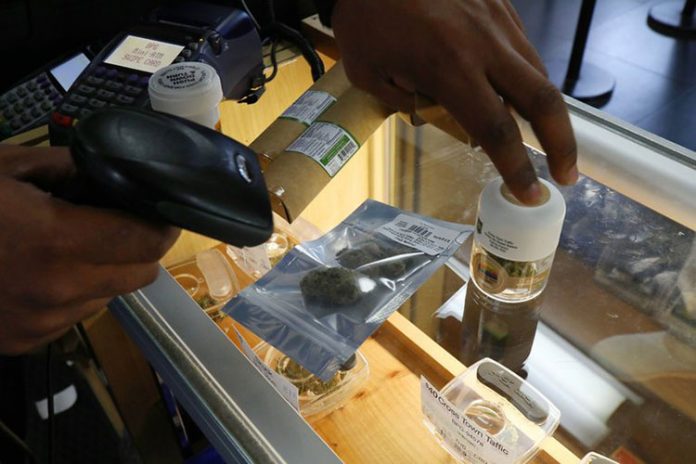Marijuana legalization opponents like Jeff Sessions may argue that “good people don’t smoke marijuana,” but as it turns out, homeowners could have far worse neighbors than marijuana retailers.
Medical marijuana dispensaries weren’t correlated with an increased rate of violent crime in their surrounding neighborhoods, according to a new study that analyzed crime rates in South Los Angeles by researchers at the University of California, Riverside.
That could be comforting news to many residents of California, where the controlled substance just became legal for recreational use at the start of 2018. (The federal government announced two days later that it would reverse an Obama-era hands off approach to marijuana prosecutions; the fallout from that has yet to be felt.)
But it’s not the shop’s merchandise that seems to make the difference, researchers found. “Many dispensaries also have property safeguards like security guards and cameras to deter crime that liquor and tobacco stores may not,” said Andrew Subica, one of the report’s co-authors. But he also noted that just because the study’s findings could not prove that violent crime rates rose around dispensaries, that doesn’t mean they aren’t linked with violence in South Los Angeles.
In fact, medical marijuana dispensaries were correlated with a higher rate of property crimes such as vandalism or shoplifting. Subica said the study’s results suggested that marijuana dispensaries could become community problems as a result.
Tobacco and liquor stores are linked to higher crime
Comparatively, the presence of a tobacco shop or liquor store was linked with a significant increase in violent crime, researchers found. Tobacco shops might be linked with high crime rates in part because they often sell other potent, legal psychoactive substances like synthetic cannabis and salvia, in addition to smoking paraphernalia, researchers said.
Liquor and tobacco stores tend to stay at one location for many years, whereas dispensaries open and close more frequently as they test out neighborhood demand. So the former are more likely to create and/or attract more long-term problems.
Big-box stores and fast-food joints may also spell trouble
While dispensaries make better neighbors than tobacco or liquor stores, these are the not the only retailers consumers should pay attention to when moving to a new neighborhood. Everything from big-box stores to fast-food restaurants to payday lenders have been associated with elevated rates of crimes such as burglary and assault.
Big-box stores in particular have long attracted crime — in part because they were more likely to be located in higher-crime areas where residents were less politically active (and therefore less likely to block the stores from coming in).
In the past, the parking lots of these stores were popular among criminals because they were poorly lit, but now crimes like shoplifting are more likely to occur inside these stores as companies have reduced the number of people they employ, Time magazine reported.
Foreclosed properties reduce property values and attract crime
Other neighborhood features are more obviously correlated with higher or lower crime rates. For instance, a neighborhood with a higher number of foreclosed properties often has a higher crime rate since people could more easily break into the buildings if they become abandoned.
When your neighbors can’t keep up with their house payments, it can spell trouble for the whole neighborhood. Foreclosed homes are not only more likely to fall into disrepair and blight the landscape, they can reduce the value of nearby homes.
On average, home property values drop nearly 1% when they’re within one-eighth of a mile from a foreclosed single-family residence, according to the Woodstock Institute, a research group, and the Georgia Institute of Technology.
Coffee shops and credit unions bode well for neighborhoods
Comparatively, coffee shops, credit unions and banks are linked with improved neighborhood safety. As arbiters of gentrification, coffee shops are thought to better public safety in many ways. The clientele they attract may be more inclined to shop at other nearby establishments, raising the economic profile of a neighborhood at the same time as it displaces other businesses that may attract crime.
Researchers have suggested that coffee shops may indeed just make a neighborhood look nicer, but also give people who have leisure time and disposable income to congregate. And well-populated areas are typically safe neighborhoods.
Nearby banks and credit unions obviously make it easier to open a checking or savings account. Consequently, people in the area will be more inclined to deposit their money into such an account rather than stash it (quite literally) under a mattress — and that makes their homes and businesses less attractive targets to burglars.
Well-maintained green spaces help reduce crime rates (in most cases)
Although previous research suggested that areas with more greenery might attract crime because leafy plants would provide cover to hide illicit activities, a recent study in Baltimore found that a 10% increase in tree canopy was associated with a roughly 12% decrease in crime.
As a general rule, such public spaces should be well lit and well used to deter crime, urban planners say.
But don’t assume that just because a neighborhood is becoming gentrified means that it will become safer. Researchers disagree as to whether the gentrification comes first or the lower crime rates. and the process of gentrification could actually cause crime to be displaced to once-safer parts of a city.














